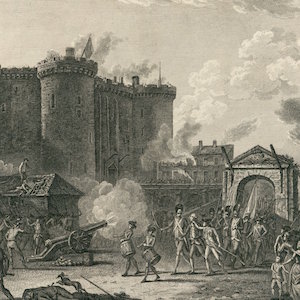Military

Foundation of the Republic, August 10, 1792
One of the sharper engagements of 10 August between the revolutionaries and the royal defenders occurred on the palace’s steps. The caption emphasizes the revolutionaries’ point of view.

Siege of the Tuileries
This hand–tinted engraving depicts the storming of the Tuileries Palace by what appear to be small groups of well–organized soldiers of the Marseilles National Guard.

Triumph of the Parisian Army and the People
Returning home from the October march to Versailles, the women and the guardsmen display the heads of troops who confronted the marchers. Note the use of tree branches, symbolizing support for the revolution here as in other prints.

Memorable Day at Versailles, 5 October 1789
This engraving marks success and reconciliation among revolutionaries, as men and women, as well as soldiers and civilians, relax together.

Farewell Bastille
This hand–colored engraving equates the taking of the Bastille with the rise of the Third Estate against the clergy and nobility. A commoner in a black hat sporting a tricolor cockade plays the bagpipe triumphantly over the fallen lion of the absolutist monarchy.

Punishment of Foulon
This engraving reveals the aftermath of the seizure of the Bastille. Here the crowd parades the severed head of the official, Foulon.

Attack on the Bastille
This engraving of the attack highlights the heroism of the people charging determinedly into the billowing clouds and firing relentlessly in the face of strong resistance emanating from the fortress.

Lila-Pilipina Brochure
The Lila-Pilipina Brochure is a creation of the feminist group of Filipino “comfort women" called Lila-Pilipina, who have banded together with feminist goals/messages for peace.

Taking of the Bastille
This painting emphasizes the populace’s participation in the storming of the Bastille, showing the urban population fighting under a red banner with muskets, swords, and pikes against the royal soldiers.

An Ordinary Guillotine
The guillotine was first introduced as a humane, efficient, and above all modern form of execution in April 1792; during the radical phase of the Republic, it would become the symbol of the Terror. This engraving suggests the guillotine is providing "good support for liberty."